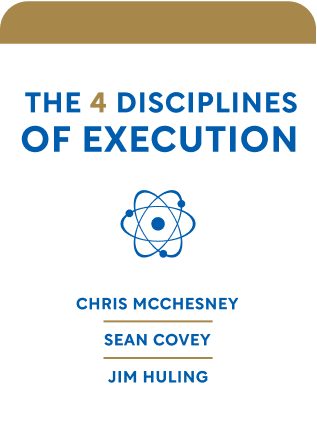

This article is an excerpt from the Shortform book guide to "The 4 Disciplines of Execution" by Chris McChesney, Sean Covey, and Jim Huling. Shortform has the world's best summaries and analyses of books you should be reading.
Like this article? Sign up for a free trial here .
What is the 4DX process for selecting wildly important goals, or WIGs? How can this method help you?
The 4DX process for selecting WIGs includes four steps. You have to start by brainstorming, then assess and test, before formalizing the goal.
Read on for more about the 4DX process for selecting WIGs.
The 4DX Process: How to Select WIGs
A WIG must challenge your team, but it must also be achievable. Don’t game your team by choosing something impossible while privately thinking if they manage 75% of it, you’ll be happy. Long-term, this will affect your ability to engage your team and produce results.
There are four steps in the 4DX process for selecting WIGs:
Step 1: Brainstorm a List of Possible WIGs
To brainstorm, come up with ideas on your own and consult team members and peer leaders, if applicable.
Shortform Example: Book Production Department: Brainstorming
Each implementation section, throughout the whole summary, will reference the experience of the production department of a publishing house.
Maria is the leader of the production department of a large publishing house. When the publishing house started implementing 4DX, the senior leaders came up with this overall WIG: “Decrease costs from $1 million to $800,000 by the end of the year.”
The production department (and all the other departments of the publishing house) brainstormed team WIGs that would support the overall WIG. Maria and her team came up with a list of ideas such as:
- Reduce the need for outside help such as freelance designers and photographers
- Reduce the number of at-press changes (once the printer has set up files, there’s a charge per changed page)
- When purchasing stock images, avoid the more expensive rights-managed agencies
Step 2 in the 4DX Process: Assess Impact
Once you have a list of possible WIGs, determine the ones that have the most impact on the overall WIG.
Some guidelines:
- If the overall WIG is financial, then the team WIG should have something to do with money: revenue, profitability, cost savings, etc.
- If the overall WIG is quality, then the team WIG could have something to do with productivity or customer satisfaction.
- If the overall WIG is strategic, then the team WIG could address the mission, new opportunities, or how to reduce threats.
Shortform Example: Book Production Department: Assessment
Maria and her team calculated the possible savings of all their ideas. Maria now knew which WIG would reduce costs most in her department, but she was looking for a WIG that would have the greatest contribution to the entire publishing house. At-press changes were not only expensive, they also caused a delay. When books printed a week later than scheduled, the marketing department had to pay for rush rather than regular shipping to ensure books made it to events on time. Marketing would also benefit from the stock image idea. Every time a rights-managed image is used, there’s a fee. If book covers used royalty-free images instead, marketing could then reuse the image in press kits and promotion materials without any additional cost.
Step 3: Test the Top Team WIG Candidates
Test each potential WIG during step 3 of the 4DX process. If the answers to all of the following questions are yes, the WIG passes the test.
- Does it support the overall WIG? Review step 2 of the 4DX process.
- Is there a way to measure it? There must be a way to measure it from the very first day. If you have to build a measurement system, choose a different WIG, because there’s no point starting 4DX without a score.
- Can your team achieve the WIG without significant help from another team? Your team should have at least 80% ownership. If it doesn’t, your team won’t feel engaged and accountable. However, it’s fine for two teams to have the same WIG, though, as long as they’re aware they share the outcome (both succeed or both fail)
- Are the results driven by the team rather than the leader? The team needs to have an impact on the results or they won’t be engaged.
Shortform Example: Book Production Department: Testing
Maria and her team tested all their ideas and chose to reduce at-press changes. This supported the overall goal, was easy to measure, didn’t depend on other teams, and the results were team-driven.
Step 4: Write the WIG in the “From Point A to Point B by Deadline” Format
Start with a simple verb.
- Good: Cut costs…
- Bad: In order to create a reduction in costs, we anticipate…
The lag measure must be expressed as “from point A to point B by deadline.”
- Good: from 85% to 95% customer satisfaction by February 28
- Bad: Increase customer satisfaction
Be concrete, precise, and simple.
- Good: Reduce time lost incidents from 8 per year to 1 per year by March 31.
- Bad: Our aim is to increase safety, according to our mission, which is…
Don’t put in any language about how you’re going to do it.
- Good: Increase profit from $8 million to $10 million over six months.
- Bad: Increase profit from $8 million to $10 million over six months by increasing revenue in the following five areas…
Shortform Example: Book Production Department: Statement
Maria and her team came up with this WIG: “Decrease costs for at-press changes from $4000 to $1000 by the end of the year.”
Yield From the 4DX Process
After implementing Discipline 1, you’ll have a WIG statement in the form of “[Simple verb] from [point A] to [point B] by [deadline].” If you’re applying the discipline across an organization, all of your teams will have their own WIG statement in this format, and the team WIGs will directly support the overall WIG.

———End of Preview———
Like what you just read? Read the rest of the world's best book summary and analysis of Chris McChesney, Sean Covey, and Jim Huling's "The 4 Disciplines of Execution" at Shortform .
Here's what you'll find in our full The 4 Disciplines of Execution summary :
- The 4 disciplines that can make any strategy a successful reality
- Why a great plan falls apart when you don't think adequately about execution
- The 6 steps you need to scale the 4DX model across an entire organization






